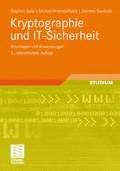Zusammenfassung
Asymmetrische Chiffren benutzen Paare von Schlüsseln. Ein solches Schlüsselpaar gehört zu einer bestimmten Person oder Instanz. Ein Schlüssel e eines Paares ist öffentlich. Der andere Schlüssel d ist privat und geheim. Er kann nur von dem Besitzer des Schlüssels benutzt werden. Die Schlüssel e (encryption) und d (decryption) eines Schlüsselpaares hängen natürlich zusammen. Aber es ist praktisch nicht durchführbar, aus dem öffentlich bekannten Schlüssel e das private und geheime Gegenstück d zu berechnen.
Access this chapter
Tax calculation will be finalised at checkout
Purchases are for personal use only
Preview
Unable to display preview. Download preview PDF.
Rights and permissions
Copyright information
© 2011 Vieweg+Teubner Verlag | Springer Fachmedien Wiesbaden GmbH
About this chapter
Cite this chapter
Spitz, S., Pramateftakis, M., Swoboda, J. (2011). Asymmetrische Chiffren. In: Kryptographie und IT-Sicherheit. Vieweg+Teubner. https://doi.org/10.1007/978-3-8348-8120-5_4
Download citation
DOI: https://doi.org/10.1007/978-3-8348-8120-5_4
Publisher Name: Vieweg+Teubner
Print ISBN: 978-3-8348-1487-6
Online ISBN: 978-3-8348-8120-5
eBook Packages: Computer Science and Engineering (German Language)

